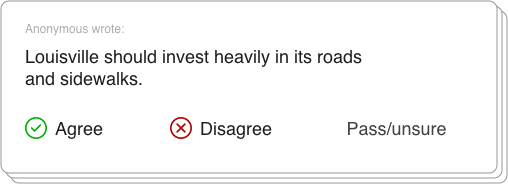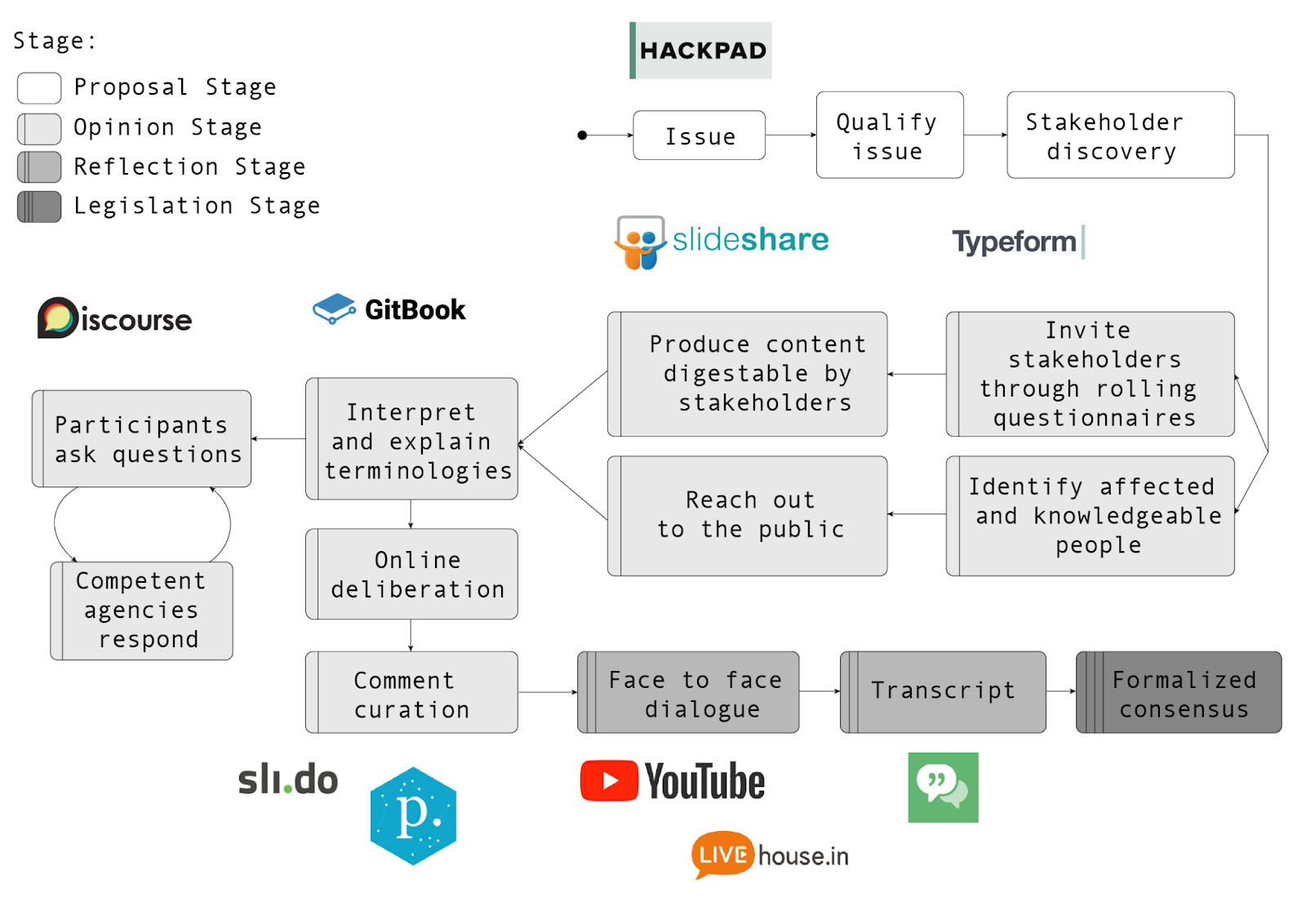Week 0.2 - thoughts on participatory digital tools
We’re exploring how digital tools and technology could help to make grant-making radically more participatory. That means ceding decision-making power to the very communities that funders aim to serve.
It’s week 2, and we’re kicking off together next week, so it’s still early days. The only thing we can be sure of is that things will change!
We write weeknotes as an open and transparent way of documenting our thoughts, feelings, ideas and progress. Please read them so you can set us straight on any misunderstandings or pitfalls before we’re knee-deep in the project :)
Short version: Since the kick-off got nudged back to next week, I took the opportunity to look a bit closer at what digital tools help communities come together in participatory ways. I’m not trying to evaluate them for PGM’s purposes, but rather I’m looking for inspiration and to spark ideas. It’s been a couple of years since I last did this and things move quickly!
Three things I’ve learnt:
- Facebook promotes divisive posts, groups, and encourages trolling 👺
- Participatory City use a suite of digital tools to support a participatory culture 🧰
- Polis is good at identifying areas of agreement within a community 🤝
Long version: thoughts so far
Facebook promotes divisive content and groups

A comment on Facebook replying to an invitation to a drop-in session for residents of Jaywick to talk to Essex County Council. For more check out the responses on the Jaywick Community Forum Facebook Group.
Facebook Groups is a way for people who share an interest to communicate together on Facebook, on a closed forum. In 2017 Zukerberg blogged that “there is a real opportunity to connect more of us with groups that will be meaningful social infrastructure in our lives.”
Then last year we learnt how Facebook was aware that the company’s algorithms weren’t bringing people together after all, but driving them apart. A slide from an internal team’s presentation in 2018 read “our algorithms exploit the human brain’s attraction to divisiveness”. It warned that if left unchecked this system would continue to feed users “more and more divisive content in an effort to gain user attention & increase time on the platform.”
On a national scale we’ve seen how Facebook’s Groups have provided private places conspiracy theories to spread, radicalised groups to form and for organising real-life violence. Facebook’s own researchers found that “64% of all extremist group joins are due to our recommendation tools”
On a smaller level, the algorhythms are at play too. They choose what posts to promote on a users feed. This is a contrived example, but a post about something you’d likely agree with, for example ‘someone trying to organise a local litter pick’ will be less likely to appear on your news feed than something more devise (and therefore more engaging), for example someone complaining about kids hanging out on the street corner late in the evening.
The net result of all of this is that trolling, arguments and disagreement are the prevailing forces on the platform. The challenge is that people are glued to Facebook, so if you’re planning on organising people or local projects it feels like the natural place to go. And getting people to switch to new platform you’d have to be offering something of significant value.
💡 Facebook has incredible demographic data about its users. Rather than using it to host a group, a deliberation or trying to organise people, what if you took out hyper-targeted ads at the people you’re looking to engage, but promoted them to respond or engage elsewhere?
Participatory City use a suite of digital platforms
Participatory City is such a wonderful thing. Everytime I go and look at it I come away totally inspired and in awe of what is happening. If you don’t know much about what it is, then this illustrated guide is the perfect place to start.
This illustration does a good job of showing how it’s two interconnected systems working together to promote a participatory culture:

I thought it’d be interesting to have a look at what digital tools they’ve adopted (or built) to support the community. It’s worth noting that _a lot _of what it does is support people and projects with physical space (like shops) or with support from a trained team. I was curious to see what digital products have been adopted to help.
In their year 2 report I learnt that they shifted their strategy. Original they had planned to build a new, bespoke stand alone digital platform. Now they’d decide to use a suite of existing platforms instead.
This is the suite they’re using:
>>>>> gd2md-html alert: inline image link here (to images/image3.png). Store image on your image server and adjust path/filename/extension if necessary.
(Back to top)(Next alert)
>>>>>

I also noticed that in response to the pandemic, they’ve moved to hosting their events and community online using Mighty Networks as opposed to Facebook, where I presume most of the residents already have an account. As you might expect, this isn’t without its challenges (people struggling to get into Zoom rooms, people not sure how a new message board works) but I’m impressed to see there’s still plenty of activity going on!
💡 The suite of tools is interesting. I reckon there’s a similar map for digital products that can help at different stages of the Participatory Grant Making journey.
I think it’s really important to pay attention to the fact they switched from thinking about a single, custom built platform to settle on implementing a suite of digital tools. Two reasons:
-
It would take a huge effort for a tech team to build a platform to support everything that Participatory City are doing. Who would support such a platform going forward? \
-
In trying to reconfigure current digital products, where are the gaps? Lots of these products weren’t built for community organising. Monday.com is a project management tool for workplace teams. Mighty Networks helps online content creators build their followings and host online courses. Reconfiguring can get us so far, but are there specific community needs for digital products that don’t yet exist?
Polis is good at identifying areas of agreement within a community
I’ve heard Polis referenced enough times now that I had to do a deeper dive into what it is and how it works. Here’s what I’ve learnt.
Polis is a digital platform where a large group of people can debate a given topic. They do this by posting comments and by voting whether they agree with or disagree with other people’s comments.
Importantly, there’s no ‘reply’ button. This drastically reduces the trolling.
The agreeing and disagreeing then means Polis can analyse these responses to identify groups of participants who voted similarly to each other, and differently from other groups. This way it surfaces areas of agreement and disagreement.
Let’s look at an example:
Last February, The American Assembly and WFPL independent radio conducted “The Next Louisville: Civic Assembly”, a community-driven virtual conversation. The goal was to explore the issues that matter most in Louisville — and to identify potential solutions. They used Polis to get participants to suggest and respond to one another’s statements.
The only direction was a framing question: “What do you believe should change in Louisville to make it a better place to live, work and spend time?”
Participants would then be able to suggest ideas and vote on other people’s suggestions. Like this:

Over 3 weeks, nearly 1,400 people participated!
Polis then could show where agreement and disagreement lies within the Louisville voting community. It distinguished two broad groups: a small Group A (128 people) with generally conservative views and a much larger Group B (1,037 people) with more liberal views.
Polis also then can identify which statements divided the communities and which were ones people agreed on.
Here’s the most divisive statement, marked by sharp differences between Groups A and B:
>>>>> gd2md-html alert: inline image link here (to images/image5.png). Store image on your image server and adjust path/filename/extension if necessary.
(Back to top)(Next alert)
>>>>>

Whereas here’s one on which nearly everyone agreed:

If you’re interested in finding out more, you can check out the full report it generated here.
💡 What if funds started local conversations asking “how could things be better in Torquay?” to identify areas of interest?
💡 What if communities could use Polis to tell funders where there’s consensus for change? Who could bring them together?
While I was looking into Polis, I looked at vTaiwan - an open consultative process that informs Taiwan’s government policy. On their website, they have mapped how they work:

See how they’ve taken a similar approach as Participatory City? They’ve mapped their process into four stages and identified digital tools that help at each stage…
Anyway, that’s turned out a lot longer than I anticipated. As I said at the beginning, I went wide here, my heads still spinning - but I’ve come away inspired.
Looking forward to getting started next week :)
Let us know what you think.
Paul & Ian
